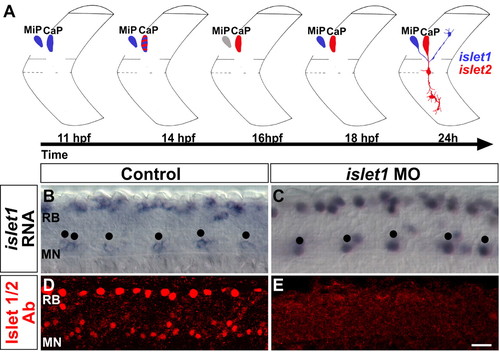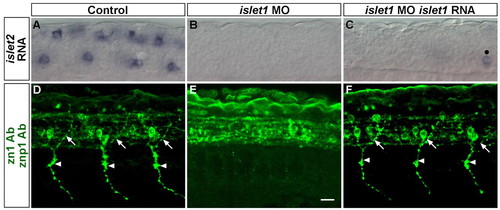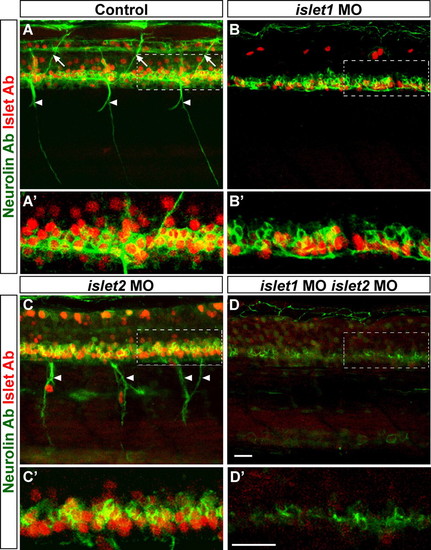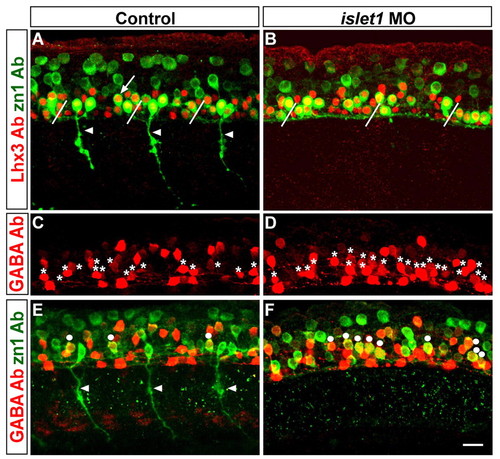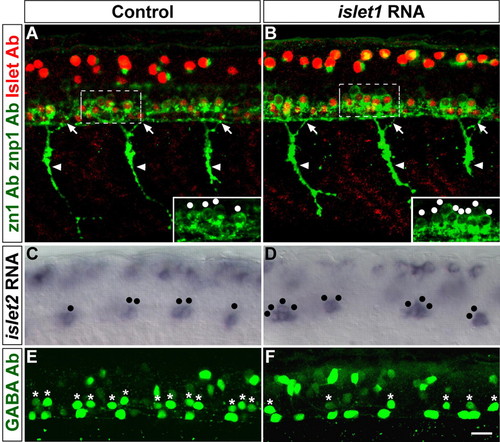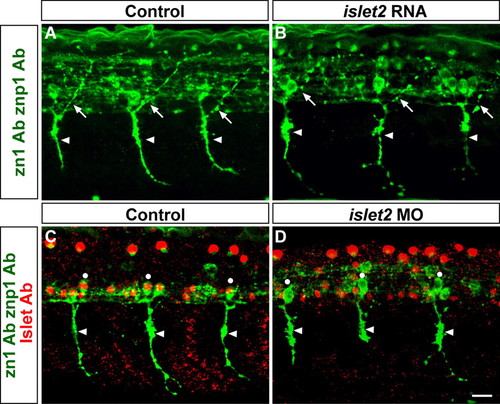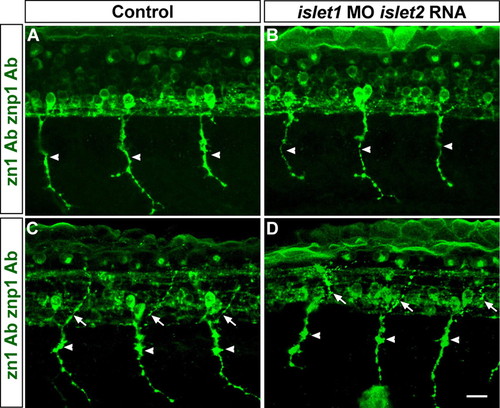- Title
-
Islet1 and Islet2 have equivalent abilities to promote motoneuron formation and to specify motoneuron subtype identity
- Authors
- Hutchinson, S.A., and Eisen, J.S.
- Source
- Full text @ Development
|
Islet1 regulates Islet2 expression. In this and subsequent figures, all photographs show 8-12 segment region of whole-mount embryos with rostral towards the left and dorsal towards the top, unless otherwise noted. (A) Schematic showing expression of islet1 (blue) and islet2 (red) in CaP and MiP between 11 and 24 hpf. Blue and red stripes indicate co-expression of islet1 and islet2; grey indicates downregulation of islet1. (B) At 20 hpf, islet1 RNA is expressed in dorsal Rohon-Beard sensory neurons (RB) and MiPs in control embryos. MN designates the row containing MiPs; individual MiPs are marked by black dots. In the segment farthest to the left, both MiP and RoP are indicated by black dots. RoPs are PMNs that express islet1 later than MiPs (Appel et al., 1995), and thus are absent from most of our figures. (C) islet1 MO-injected embryos express islet1 in RBs and MiPs, but the RNA is nuclear instead of cytoplasmic as it is in controls (47% of PMNs have nuclear islet1 RNA staining in islet1 MO-injected embryos when compared with 1% in controls*; n=7 islet1 MO-injected embryos; n=8 control embryos); black dots indicate MiPs. (D) At 28 hpf, Islet Ab (red) labels RBs and motoneurons (MN) in control embryos. (E) Islet Ab labeling is absent from islet1 MO-injected embryos (92% fewer cells labeled with Islet Ab in the pMN domain*; n=22 islet1 MO-injected embryos; n=26 control embryos). *P<0.001. Scale bar: 20 µm. EXPRESSION / LABELING:
|
|
Islet1 is required for PMN formation. (A-C) 20 hpf embryos stained with islet2 riboprobe. Control embryos (A) express islet2 in RBs (dorsally located cells) and CaPs (ventrally located cells). islet1 MO-injected embryos (B) lack islet2 expression. islet1 MO-injected embryos co-injected with islet1 RNA (C) also lack most islet2 expression; one islet2-positive PMN is indicated by a black dot. (D-F) 28 hpf embryos stained with zn1 and znp1 Abs (green). Control embryos (D) have dorsally projecting MiP axons (arrows) and ventrally projecting CaP axons (arrowheads). islet1 MO-injected embryos (E) lack both MiP and CaP axons. Co-injection of islet1 MO and islet1 RNA (F) restored both MiP and CaP axons. Scale bar: 20 µm. EXPRESSION / LABELING:
PHENOTYPE:
|
|
Islet proteins are required for SMN formation. (A-D) 72 hpf embryos stained with Neurolin (green) and Islet (red) Abs. For each panel, one segment (outlined) is magnified and shown below (A'-D'). Control embryos (A) had dorsally projecting (arrows) and ventrally projecting (arrowheads) Neurolin-positive SMNs and many Islet-positive cells. islet1 MO-injected embryos (B) lacked SMN axons and had 52% fewer Islet-positive cells (*P<0.01, 18 segments of three embryos). islet2 MO-injected embryos (C) had 10% fewer SMN cell bodies (*P<0.01, 24 segments of four embryos). These embryos entirely lacked dorsally projecting SMN axons and ventrally projecting SMN axons (arrowheads) were disorganized. The cells labeled with Islet Ab outside the neural tube next to the ventrally projecting axons are most likely dorsal root ganglion cells that are out of position. Embryos co-injected with islet1 and islet2 MOs (D) lacked all SMNs and 99.5% of Islet-positive cells were absent (*P<0.01, 18 segments of three embryos), although Neurolin-positive floor plate was still present. Scale bars: 20 µm. EXPRESSION / LABELING:
PHENOTYPE:
|
|
Islet1 is required to inhibit interneuron formation. (A,B) Embryos co-stained with Lhx3 (red) and zn1 (green) Abs. (A) In control embryos, zn1 and Lhx3 were co-expressed in motoneurons that projected axons (arrowheads) out of the spinal cord and in VeLD interneurons (one is indicated by an arrow; slanted lines denote somite boundaries). (B) islet1 MO-injected embryos had cells that co-expressed Lhx3 and zn1, but they did not project axons out of the spinal cord, and instead had axons that projected caudally within the spinal cord. (C,D) Embryos stained with GABA Ab. (C) In control embryos, GABA Ab reveals KA'', KA', VeLD and other (unidentified) interneurons; cells in the V-K position are marked by asterisks. (D) Cells in the V-K position (asterisks) are more numerous in islet1 MO-injected embryos. (E,F) The same embryos shown in C and D, but here showing co-labeling with GABA (red) and zn1 (green) Abs. Dots indicate cells co-expressing GABA and zn1. (E) In control embryos, only a few cells co-express these markers. Arrowheads in E indicate CaP axons. (F) In islet1 MO-injected embryos there are many more cells that co-express zn1 and GABA. All embryos shown in this figure are at 28 hpf. Scale bar: 20 µm. |
|
Misexpression of islet1 RNA induces PMN formation and inhibits interneuron formation. (A,B) 28 hpf embryos labeled with zn1 and znp1 (green) and Islet (red) Abs. Control embryos (A) have MiP axons (arrows), CaP axons (arrowheads) and several PMN cell bodies (inset; zn1 Ab; dots). Misexpression of islet1 RNA (B) causes a thicker ventral motor nerve (arrowheads) and more zn1-positive cell bodies (inset, dots). (C,D) 20 hpf embryos labeled with islet2 riboprobe. islet2 is expressed in one or two PMNs per segment (black dots) in control embryos (C); the second cell is VaP, a duplicate CaP that is sometimes present and typically dies (Eisen et al., 1990). islet2 is expressed in two to four PMNs per segment in embryos misexpressing islet1 RNA (D). (E,F) 28 hpf embryos labeled with GABA Ab. The number of cells in the V-K position (asterisks) is decreased in embryos misexpressing islet1 RNA (F) when compared with controls (E). Scale bar: 20 µm. EXPRESSION / LABELING:
|
|
Formation of CaP subtype identity is independent of Islet2. (A,B) Embryos labeled with zn1 and znp1 Abs (green). Arrows indicate MiP axons, arrowheads indicate CaP axons. At 28 hpf, control embryos (A) have both CaP and MiP axons. Embryos misexpressing islet2 RNA (B) also have normal MiP and CaP axons. (C,D) Embryos labeled with zn1 and znp1 (green), and Islet (red) Abs. Arrowheads indicate CaP axons. CaP cell bodies (dots) co-label with Islet and zn1 Abs and project axons ventrally at 28 hpf in control embryos (C). islet2 MO-injected embryos (D) lack Islet staining in CaP cell bodies and have abnormal CaP axons. Scale bar: 20 µm. |
|
Islet1 and Islet2 can function redundantly in PMN formation. (A-D) 28 hpf embryos stained with zn1 and znp1 (green) Abs. CaP axons are indicated by arrowheads; MiP axons are indicated by arrows. Control embryos (A) have normal CaP axons. Embryos co-injected with islet2 RNA and islet1 MO (B) have normal CaP axons. Control embryos (C) have dorsally projecting MiP axons. MiP axons are present in embryos co-injected with islet1 MO and islet2 RNA (D). Scale bar: 20 µm. EXPRESSION / LABELING:
|

